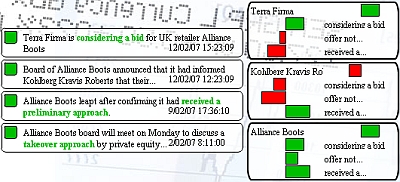Programming the Next Generation of Stockbrokers
By Maaike Siegerist
November 27, 2009
 Stock prices are volatile, they may rise or fall within a few milliseconds after new information becomes available. It is vital for stockbrokers to process new data on the fly and act fast based on the newly acquired information. Easier said than done, considering the magnitude of the amount of data that becomes available each second through the Internet and other media. Automation promises to be the ideal solution, yet there is one big challenge: making machines understand the meaning of news.
Stock prices are volatile, they may rise or fall within a few milliseconds after new information becomes available. It is vital for stockbrokers to process new data on the fly and act fast based on the newly acquired information. Easier said than done, considering the magnitude of the amount of data that becomes available each second through the Internet and other media. Automation promises to be the ideal solution, yet there is one big challenge: making machines understand the meaning of news.
At the Erasmus Centre for Business Intelligence, Uzay Kaymak and Flavius Frasincar are working in this field, thereby contributing to the movement to make the Web machine-understandable – to enable computers to comprehend Web content. At the same time, young enterprises such as the Dutch company SemLab are turning semantic solutions into profitable products, not in the least in the financial sector.
The Semantic Web and Algorithmic Trading
 “I have a dream”, wrote Tim Berners-Lee, the inventor of the Web in 1999. Barely a decade earlier, he had first conceived the World Wide Web and on Christmas Day 1990, he and a team of enthusiastic researchers had managed to establish the first Web connection. In 1999, he went beyond his initial conception of a global data network as he envisaged a Semantic Web, in which computers “become capable of analyzing all the data on the Web – the content, links, and transactions between people and computers.” When such a Web would emerge, he predicted that “the day-to-day mechanisms of trade, bureaucracy and our daily lives will be handled by machines talking to machines.”
“I have a dream”, wrote Tim Berners-Lee, the inventor of the Web in 1999. Barely a decade earlier, he had first conceived the World Wide Web and on Christmas Day 1990, he and a team of enthusiastic researchers had managed to establish the first Web connection. In 1999, he went beyond his initial conception of a global data network as he envisaged a Semantic Web, in which computers “become capable of analyzing all the data on the Web – the content, links, and transactions between people and computers.” When such a Web would emerge, he predicted that “the day-to-day mechanisms of trade, bureaucracy and our daily lives will be handled by machines talking to machines.”
Researchers at Erasmus Centre for Business Intelligence have a long tradition with Web developments. Eelco van Asperen was one of the pioneers in developing Web browsers for PC systems. Currently, researchers at the Erasmus Centre for Business Intelligence focus on the realization of the Semantic Web vision and its economical applications. In particular it is studied how the Semantic Web can be applied to support decision making through information personalization. Personalization means “trying to get to the right data” – the data that meets one needs. As Flavius Frasincar explains: “Instead of browsing through thousands of Web pages, and entering queries into databases, a user can specify what his interests are, and he will be offered only that information from the Web which corresponds to those interests.”
Such research is highly relevant to the financial sector, where decision-making requires filtering specific information from diverse sources. Economic events like acquisitions, stock splits, and dividend announcements play a crucial role in the daily decisions taken by stockbrokers. Besides, stockbrokers cannot permit themselves to miss out on other news that might impact their portfolios. For instance, Shell owned many refineries in the region where Hurricane Katrina struck in 2005, which naturally affected the company’s stock prices. Machines can filter the news, and are particularly capable of dealing with large volumes of new information.
 Financial markets also depend on the reaction speed to new situations. Beating the competition by only a few milliseconds may mean better stock prices. Therefore, algorithmic trading – the use of computer programs to generate buy and sell orders on financial markets – is on the rise. According to The Economist, algorithmic trading accounted for one third of all share trades in the United States in 2006 and will make up more than half the share volumes and a fifth of options trades by 2010. In algorithmic trading there is only a very brief delay between order and execution. It enables the reading and understanding of news items even faster than the eye can scan.
Financial markets also depend on the reaction speed to new situations. Beating the competition by only a few milliseconds may mean better stock prices. Therefore, algorithmic trading – the use of computer programs to generate buy and sell orders on financial markets – is on the rise. According to The Economist, algorithmic trading accounted for one third of all share trades in the United States in 2006 and will make up more than half the share volumes and a fifth of options trades by 2010. In algorithmic trading there is only a very brief delay between order and execution. It enables the reading and understanding of news items even faster than the eye can scan.
In order to make algorithmic trading work better, news needs to be translated into a machine-understandable form. This is where the Semantic Web enters the picture. It provides the right technologies to identify or “tag” the semantic information in news items. Having this information in machine-understandable form enables computers to reason and act as we humans would do. For example, recognizing a “buy event” in a news item would enable machines to infer that the share price of the buyer might decrease and the share price of the buyee might increase (because the buyer is taking a risk and the buyee is receiving an investment). For the trader, such information would generate a sell signal for shares of the buyer and buy signal for shares of the buyee.
Commercial Application by SemLab
| The innovative Dutch company SemLab is among the businesses that develop commercial software around these ideas. SemLab and the Erasmus Centre for Business Intelligence have developed strong ties, as they have a mutual interest in intelligent systems that aid decision making. SemLab’s CTO Mark Vreijling is a longtime research partner of Erasmus University in high technology for knowledge-intensive business processes. Besides, many of SemLab’s new employees have been trained at the university’s Economics & Informatics programme. |  |
The recent crisis turns out to be an opportunity for companies like SemLab. It forces banks to cut their costs, as a result of which many are closing down their own research departments. Small, research-based companies have confidently stepped in to fill the gap, providing intelligent business software for the financial sector.
One of SemLab’s financial products is ViewerPro. ViewerPro reads news from many different sources, singles out those events that are relevant to its client’s portfolio, and makes a basic prediction about the impact of the event on stock prices. This information is then presented in a format that can be used as input for a stockbroker or for algorithmic trading. ViewerPro provides extensive market coverage, is able to process news on the fly, and has a user-friendly graphical interface. As a commercial product it applies pragmatic methods, while researchers at the Erasmus Centre for Business Intelligence work on the underlying foundations of the Semantic Web extensions for decision support systems.


